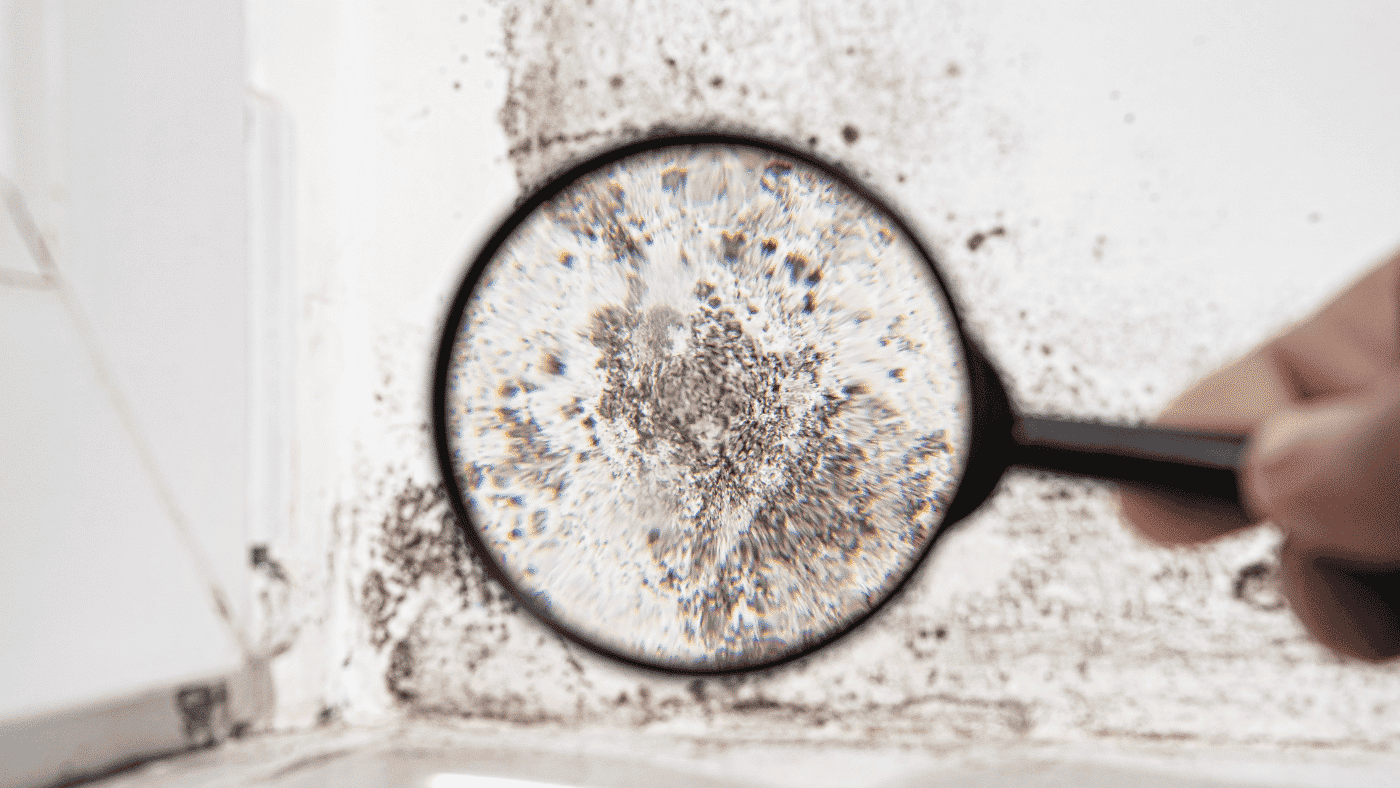Methods to Determine Cause, Origin and Age of Fungal Growth in Buildings
A. General Background
Health Effects related to the presence of mold have become a great concern to the general public. That these are important is recognized by the Environmental Protection Agency and the Occupational Safety and Health Administration. The medical profession, especially the pediatric discipline, has developed a rising concern for moisture and fungal activity within buildings.
B. Insurers and the Water Loss
For the insurance industry, their insured’s often exhibit a concern for mold growth associated with a moisture related loss. An important role for the adjuster is to determine what damage is related to the loss and what damage may have pre-existed the loss. In the presence of mold growth, the question arises “Is this long-term mold growth or is its new mold related to this loss?”
C. Evaluation of a Loss
1. A Single Focus or Source
In a water loss, water will radiate outward from a water source, be it a leaky pipe or a failed water heater tank. The water pathway may be direct or convoluted, but it is very reliable that the level of damage decreases with distance from the source of water. Adjusters investigating the loss will observe an increase in the impact of water as their survey approaches the source. It is normal and reasonable that the degree of water damage should focus upon the source of water.
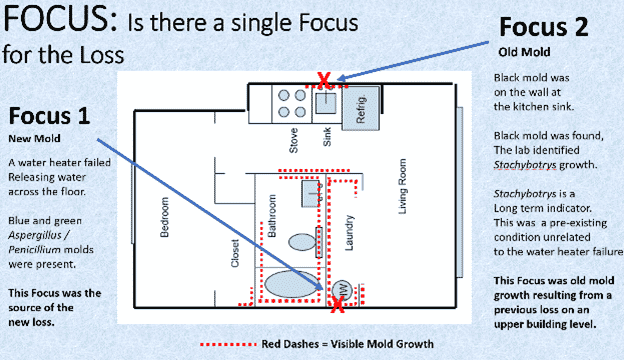
Infra-red imagery can be used to locate sources of moisture which might otherwise not be visible.
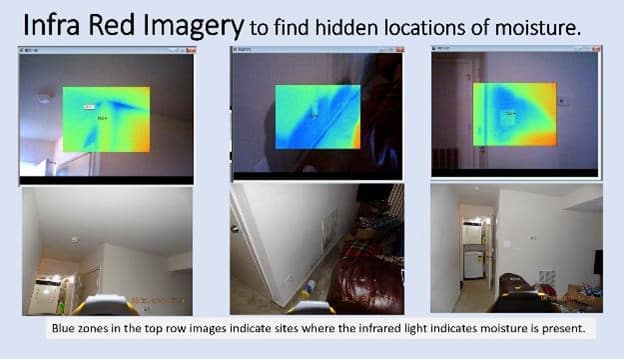
2. Multiple Foci or Sources
Occasionally, a loss investigation will reveal more than one location of heavy damage separated by an undamaged area. In this case, there is likely more than one source of moisture and more than one loss.
If there is more than a single focus, it is likely there is more than one loss, and usually there is more than one cause of the loss. Further investigation is warranted, as one condition often preexists the other by considerable time.
The following section describes common home conditions which may cause longstanding moisture conditions which manifest fungal growth.
a. Cold Zones & Thermal Bridges:
Long-term mold growth often occurs in locations where exterior cold temperatures can “short circuit” through a wall by avoiding insulation layers and warm indoor air flow is limited
b. Cold Corner:
In wood frame buildings, exterior corners usually contain several studs with limited or no insulation. The studs provide less thermal resistance than the insulation, the wall surface overlaying the stud is cooled. Wind washing of corner wall cavities and furniture blocking the corner each foster a lower temperature wall surface on which condensation may occur [1]. The presence of condensation moisture readily provides the moisture needed for mold growth on a wall surface.
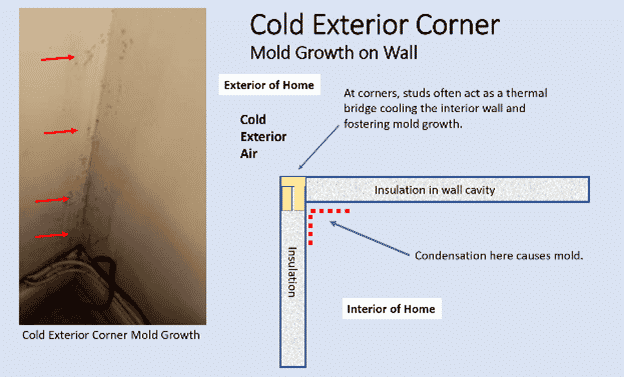
c. Cold Ceiling Juncture:
Wall / Roof junctures are also vulnerable to condensation caused mold growth as the sites are often wind washed and insulation is compressed leaving an upper corner of the wall at a cooler temperature the in the room. This provides an early condensing surface and molds with low moisture requirements may appear [2].
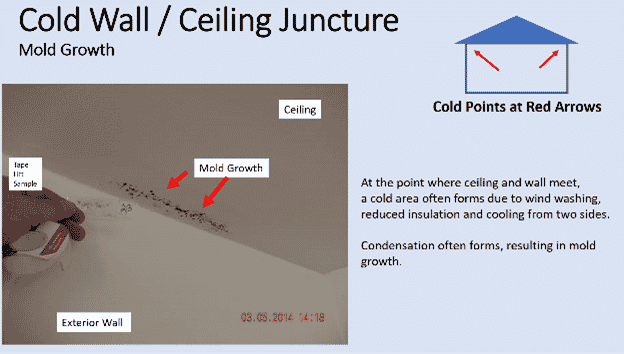
d. Closet on an Exterior Wall:
Closets rarely have HVAC systems with supply air vents in the closet. Additionally, the closet door and closet contents often block the exterior wall, preventing warming of the wall. In a heating season, the exterior closet wall is cooled by exterior temperatures and often becomes a condensing surface. Growth of molds supported by condensation moisture are not uncommon occurrences on the exterior facing wall of a closet [3].
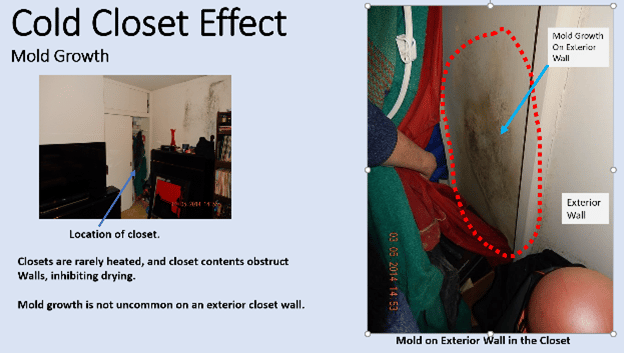
e. Cold Window and Window Frame:
Aluminum windows are very cleanable, and near maintenance free. However, the aluminum frames conduct heat very rapidly and aluminum is a poor insulating material [4]. In the heating season, interior window frame surfaces can become very cool resulting in condensation on the window. Window frames are a common site for condensation moisture and mold growth during winter months.
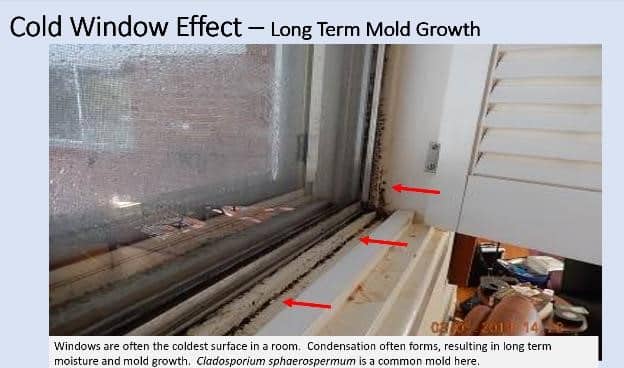
Each of the cases above require the availability of intermittent or cyclic moisture, and then intervening periods of dryness. Moisture is often provided by vapor diffusion resulting from exterior weather. Cladosporium sphaerospermum is a common occurrence in these locations due to its low moisture requirement and tolerance for dry desiccating periods.
The above are descriptions of long-term conditions. Each case description typically reflects months or years of moisture and mold activity.
3. Mold Growth from Vapor Drive
In cooling seasons, exterior humidity is usually higher than in the home where air conditioning acts as a dehumidifier. A higher moisture concentration outdoors relative to indoors results in a condition where water vapor will cross the wall diffusing into the home as water molecules follow the second law of thermodynamics. This condition of moisture moving from higher to lower concentration is known as vapor drive.
In cases where vapor drive is carrying moisture through an exterior wall, the obstruction of the wall with furniture such as a couch against the wall, often leads to mold growth on the surface of the wall behind the object.
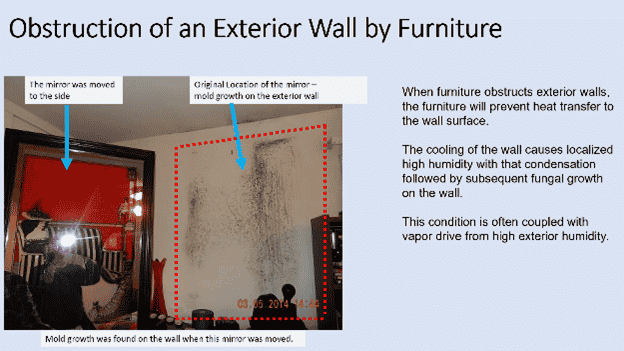
D. Foundation Moisture
Foundations are well known sources of moisture in basements. In most homes, the exterior foundation surface is dampproofed, but not waterproofed. Efflorescence residue on a foundation wall, mold growth along mortar joints and moisture measurements are indications of moisture entry through a foundation.
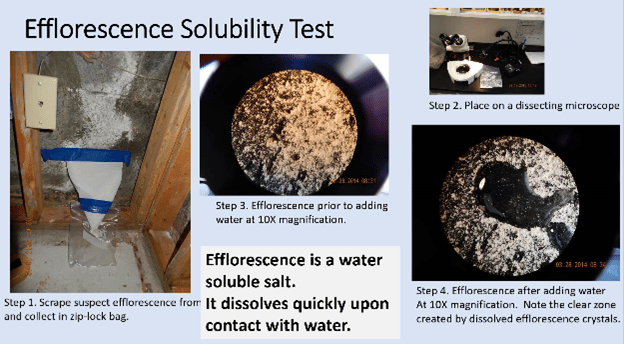
Foundation moisture is significant in that the moisture is caused by groundwater and/or surface water. The insurance coverage for foundation water entry is usually included in flood insurance. Homeowner’s policies normally exclude foundation moisture intrusion.
E. Primary vs. Secondary Fungal Growth
After a water loss, mold growth may begin after about 48 hours [5] if drying is not adequately performed. The mold growth will appear on surfaces which were directly contacted by the water. Mold growth on a surface wetted by the loss is considered Primary Mold Growth and the molds involved usually include Aspergillus / Penicillium genera.
Secondary mold growth occurs when airborne moisture rises to the point to which mold will appear on a surface that was not contacted by water. This is a condensation phenomenon caused by uncontrolled humidity. Based upon over twenty years of water loss investigation and writing protocols, at least two weeks is required for secondary mold growth to appear. Usually, the time required is much longer.
The appearance of humidity caused mold growth is an indication that either drying was not effective, drying did not occur or that pre-existing mold is present. If there is secondary mold, further investigation is warranted to determine the cause.
Secondary mold growth often includes brightly colored fungal species such as the genus Eurotium. These species have very low moisture requirements and may grow on slightly damp materials or when humidity is not controlled. Eurotium species often appear bright yellow, orange or red when found as indoor growths.
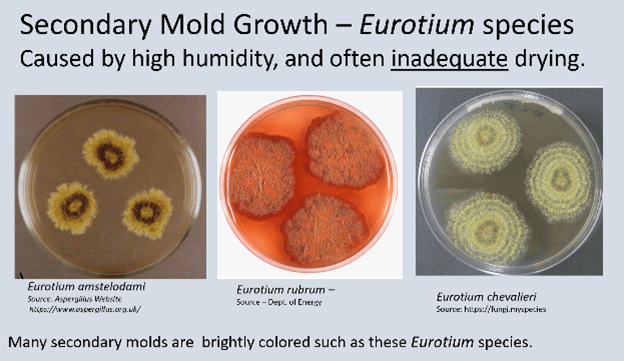
F. Biological Indicators of Age
Biological organisms usually occupy a niche where conditions are favorable to their survival and competition is minimal. The conditions required or preferred for specific indicator organisms can provide clues for the investigator concerning conditions which may not otherwise be apparent.
1. Fast Growing Fungi – Aspergillus / Penicillium:
Fungi do not perform photosynthesis and they obtain their nutrients from their surrounding environment. Sugar is an important nutrient as it provides much of the energy needed for fungal growth. Simple sugars are readily available in most biological materials. Aspergillus and Penicillium fungi are common in outdoor air, and their spores are readily transferred to the surfaces after a water release.
Due to their presence in the air, and ability to feed on simple sugars, Aspergillus and Penicillium genera are fast growing, usually initial or primary colonizers when mold appears after a water release [6]. These first-generation fungi are often blue, green or gray in color.
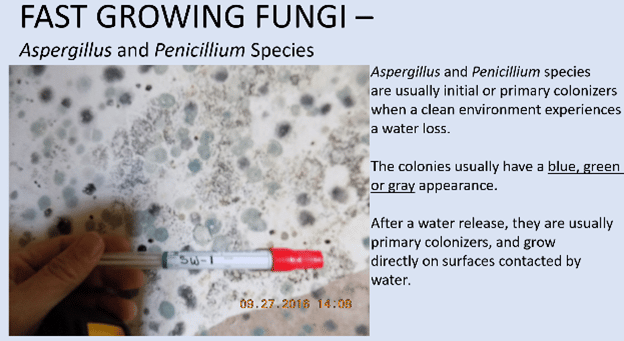
2. Wood Decay:
Dry lumber is resistant to wood rot; a wooden frame building may last hundreds of years if moisture is controlled. However, all wood eventually succumbs to fungal decay. The decay process is like a natural form of re-cycling.
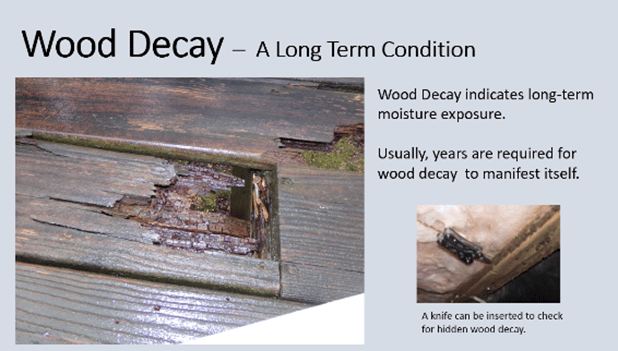
For wood to decay, the breakdown of complex carbohydrate molecules such as cellulose or hemicellulose and lignin, a polyphenolic polymer, is required. This usually requires multiple fungi working together as a process. The different fungal species each carry out a different role to degrade the wood cell structure. The process requires time for multiple species to manifest themselves and time for the process of decay.
A laboratory with analysts trained in forest or ecological microbiology can usually identify the presence of wood rot, the type of rot and the stage of decay.
“In general, the observation and detection of wood decay in a building is considered due to long term moisture issues, generally years” [7]
The presence of wood decay confirms a long-term moisture exposure in the areas sampled. If there is wood decay, further investigation for cause and origin of the condition is warranted.
3. Long-Term Indicator Organisms:
Some fungi are rarely found in outdoor air, and rely more upon transport by water, insects or small animals.
a. Stachybotrys and Chaetomium: Due to their biology, the presence of Stachybotrys and Chaetomium genera growth usually indicates many months of chronic moisture exposure. These genera require high levels of moisture and will not survive in marginally damp conditions.
Stachybotrys and Chaetomium are each highly cellulolytic; they derive energy from the breakdown of cellulose into glucose. Cellulolytic fungi are not commonly initial colonizers of lumber or other cellulose containing products.
“Stachybotrys chartarum is a tertiary colonizer fungus and produces slimy spores which indicates their dispersal is not as effective as dry spores. Because of its biology, the appearance and growth of S. chartarum usually requires at least 9 months of chronic or repeated wet conditions (Emphasis added).“[8]
“Chaetomium globosum, on the other hand, is a tertiary colonizer and a cellulytic fungus…..Based upon the author’s extensive observations, it is often found to grow after approximately 6 months of prolonged wet conditions (Emphasis added).”[9]
Exception: Stachybotrys or Chaetomium may appear more quickly after a water loss if these genera are already present. This may occur if there was prior water damage or an incomplete remediation occurred prior to the current loss.
Color: Indoors, long term growths of Stachybotrys or Chaetomium usually appear black in color.
G. Special Biological Indicator Organisms
1. Intermittent Moisture – Cladosporium sphaerospermum:
Cladosporium sphaerospermum has been called the “indoor Cladosporium” because C. sphaerospermum is usually the species present when Cladosporium growth is found indoors. Cladosporium is usually associated with sites which have experienced repeated cyclical wettings which are often related to weather and/or seasonal moisture. Cladosporium sphaerospermum can tolerate long periods of dryness, returning to growth when moisture returns. Cladosporium sphaerospermum growth has been found in locations where moisture is only present during cold winter months and growth is common in cold closets, cold corners and cold window frame surfaces. See the following quote:
“Hyphae of a number of leaf surface fungi (Alternaria, Cladosporium…) are remarkably resistant to desiccation. After extended periods of drying, desiccated hyphal tips were found to resume growth within 1 hour (Emphasis added) after return to moist conditions”[10]
2. Inadequate Drying and Aspergillus versicolor:
Aspergillus versicolor is a late primary or secondary colonizer. It does not commonly appear immediately after water damage is colonized by fungi. Aspergillus versicolor has broad moisture requirements extending into the lower (xerophilic) level of water availability [7]. Significant growth of Aspergillus versicolor often indicates a lack of drying and moisture levels which decrease slowly over a protracted period.
H. Macro – Fungal Growth – Mushrooms
Mushrooms usually indicate a protracted moisture condition. In nature, mushroom spores planted on a log in spring usually require months of exposure prior to producing mushroom fruiting bodies [11]. The cycle requires stages of growth including spores inoculation, formation of a mycelial network beneath the surface of the wood and then time for the formation of a visible mushroom fruiting body.
“Most 4” to 8” inch diameter logs fruit in one year from the time of (spore) inoculation, with some producing (fruiting bodies) in only 6 months while others take up to two years.”[12]
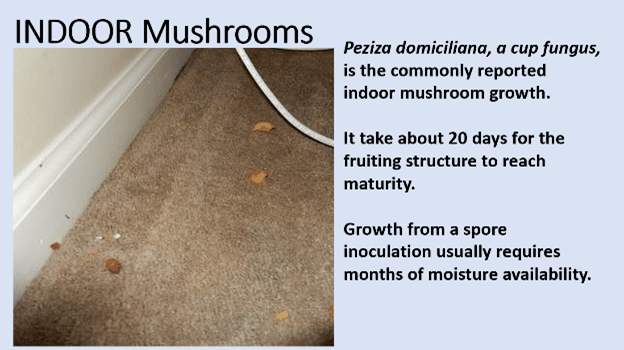
Peziza domiciliana is a commonly reported indoor “mushroom”[13]. When the fruiting body begins to a appear, about 16 to 27 days is required for a fruiting body to mature in a home[14]. Peziza domiciliana growth is depicted in Figure 12.
I. Insects
Psocid (Psocoptera) insects, fungus feeding beetles and fungus gnats may appear because these organisms feed upon fungal growth. Fungal associated Insect activity usually takes months of moldy and moist conditions to become established.
Based upon past experience, an insect infestation of a fungal growth has not been observed in less than two weeks after a water loss. Once insect are established, insect fecal pellets may appear in tape lift samples (See the image in Figure 13) collected from the mold growth. The insect fecal pellets left behind may be more readily located than the actual insects.
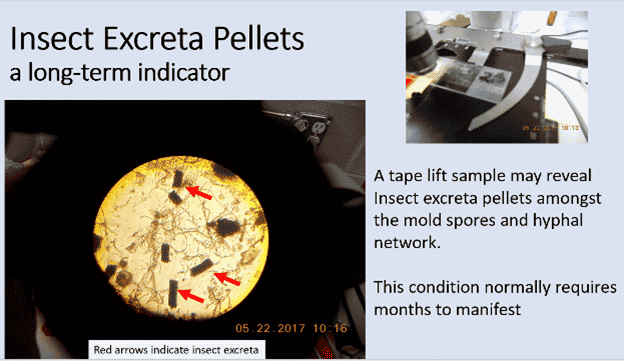
In addition to the above, observations of cockroaches, camel crickets, slugs, and millipedes normally indicate the presence of a long-term, moist condition. However, these moisture indicator organisms do not normally feed upon the fungal growth.
J. Final Comments:
The investigative methods discussed in this article reflect over twenty years of my experience in the performance of cause and origin investigations. All the work performed investigating a water loss is intended to allow the investigator to present a professional opinion concerning what resulted from the loss. As much information as reasonably possible should be gathered to form an opinion.
Opinions and conclusions should be based upon a preponderance of findings. Rarely should opinions be given based upon a single indicator condition.
Interviews can also be useful. A simple question such as asking if there was mold on a wall prior to the loss may reveal important information. Owner reports can reveal past conditions which impact the investigator’s findings and may also indicate unexpected conditions to be additionally investigated.
The observations, methods and techniques in this article can be useful to help understand an insured loss and determine what conditions resulted from that loss, and any pre-existing conditions can be identified along with a basis for their pre-existence. While there are limitations, these methods have stood for a test of time of over twenty years of investigations.
To learn more about VERTEX’s Environmental Consulting services or to speak with an Environmental Expert, call 888.298.5162 or submit an inquiry.
Download this White Paper as a PDF
Bibliography & Footnotes
[1] Lstiburek, J., Carmody, J., Moisture Control Handbook, page 9, c 1994, John S Wiley & Sons, New York, NY
[2] Lstiburek, J., Carmody, J., Moisture Control Handbook, page 9, c 1994, John S Wiley & Sons, New York, NY
[3] Lstiburek, J., Carmody, J., Moisture Control Handbook, page 9, c 1994, John S Wiley & Sons, New York, NY
[4] See Department of Energy — https://www.energy.gov/energysaver/window-types-and-technologies
[5] EPA, Mold Remediation in Schools and Commercial Buildings, September 2008, United State Environmental Protection Agency, Publication EPA 402-K-01-001 — https://www.epa.gov/mold/printable-version-mold-remediation-schools-and-commercial-buildings
[6] Yang, C., Heinsohn, P., Sampling and Analysis of Indoor Microorganisms, pg. 193, c2007, John S Wiley & Sons, Hoboken NJ
[7] Yang, C., Heinsohn, P., Sampling and Analysis of Indoor Microorganisms, pg. 222, c2007, John S Wiley & Sons, Hoboken, NJ
[8] Yang, C., Heinsohn, P., Sampling and Analysis of Indoor Microorganisms, pg. 224, c2007, John S Wiley & Sons, Hoboken NJ
[9] Yang, C., Heinsohn, P., Sampling and Analysis of Indoor Microorganisms, pg. 224, c2007, John S Wiley & Sons, Hoboken NJ
[10] Burge, H.A., Bioaerosols, pg. 113, c1995, CRC Press, Boca Raton, FL
[11] https://www.fieldforest.net/category/planting-and-harvesting-timelines
[12] Stamets, Paul, Mycelium Running – How Mushrooms can Help Save the World, c2005, Ten Speed Press, Div. of Random House, New York NY.
[13] Peziza domiciliana is more correctly referred to as a toadstool or a cup fungus. Peziza is a member of the phylum ascomycetes or cup fungi. Mushrooms are members of the phylum basidiomycetes.
[14] Pady, S. M., Observations on the Rate of Growth of Ascocarps of Peziza domiciliana, pg. 53-55, Mycologia, Vol 31, 1939, Mycological Society of America, Lawrence, KS



